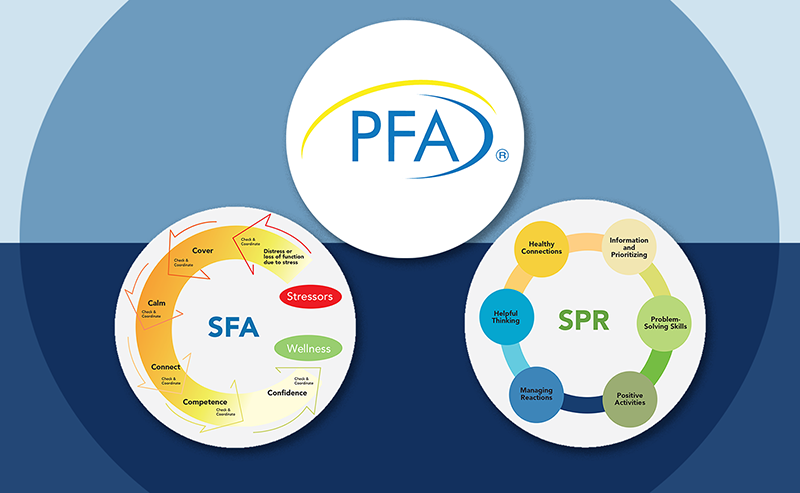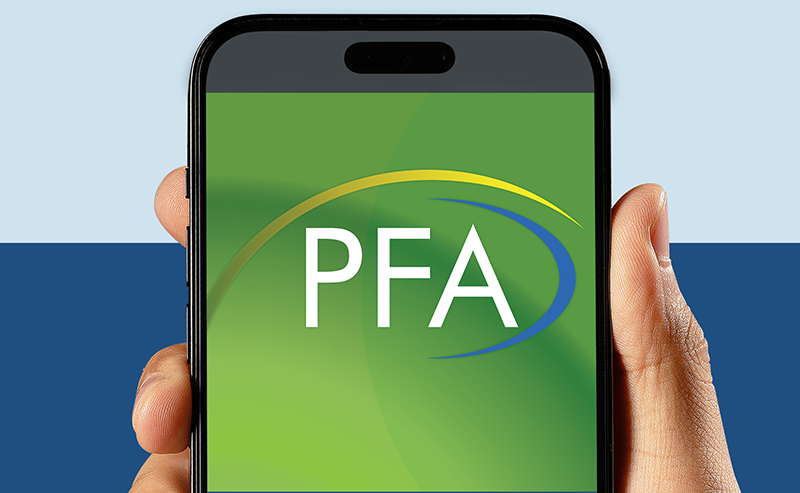PTSD: National Center for PTSD
Long-Term Treatment Interventions Following Disaster Events
Long-Term Treatment Interventions Following Disaster Events
In the immediate aftermath of disaster events, provision of practical support and psychosocial interventions like Psychological First Aid (PFA) and Skills for Psychological Recovery (SPR) are likely to be sufficient for the majority of those who are exhibiting mild to moderate distress or trouble functioning. In the months following a disaster event, a smaller proportion of the population who are exhibiting more severe or protracted reactions may benefit from more intensive interventions.
In This Article
PTSD Treatment in General Populations
Posttraumatic stress disorder (PTSD) is the most commonly studied mental health problem observed in disaster studies (1,2). Prevalence estimates range from 30% to 40% among direct victims, 10% to 20% among rescue workers, and 5% to 10% among the general population (3,4). The psychological treatments for PTSD with the strongest empirical support are Prolonged Exposure (PE), Cognitive Processing Therapy (CPT), and Eye Movement Desensitization and Reprocessing (EMDR), according to the revised (2023) VA/DoD Clinical Practice Guideline for PTSD (5). PE, CPT, and EMDR have been tested in numerous clinical trials, in people with complex presentations and comorbidities, in comparison to active control conditions, and with long-term follow-up designs (6).
PE helps people process negative trauma-related emotions and overcome avoidance through imaginal exposure (repeatedly re-telling their traumatic event) and in vivo exposure to safe situations that have been avoided because they elicit traumatic reminders. CPT has a primary focus on exploring and modifying maladaptive beliefs related to the trauma. CPT emphasizes cognitive restructuring through the use of Socratic dialogue to help people examine problematic beliefs, emotions, and negative appraisals stemming from the event, such as self-blame or mistrust (7). Those receiving EMDR engage in imaginal exposure to a trauma memory followed by imagining a more healthy cognitive reappraisal while simultaneously performing saccadic eye movements.
PTSD Treatment for Those Who Have Experienced Disaster Events
There are a number of randomized controlled trials (RCTs) of trauma-focused treatments focused on adults with PTSD resulting from mass violence and disaster. Three RCTs have been conducted with those who met criteria for PTSD as a result of exposure to terrorism or mass violence. All 3 studies evaluated standard 8-12 session trauma-focused psychotherapies that included cognitive restructuring and exposure. In 2 of the studies, trauma-focused cognitive behavioral therapy (CBT) was compared to treatment as usual (8,9) and in one it was compared to waitlist (10). In all 3 studies trauma-focused CBT resulted in significantly more improvement in PTSD relative to the control condition. In 2 out of 3 studies there were also greater reductions in symptoms of depression.
Studies of PTSD samples after natural disasters have utilized less standard trauma-focused treatments. Two RCTs documented greater decreases in PTSD symptoms, relative to control groups, among participants who received a single session behavioral treatment aimed at increasing control over earthquake related fears through confronting feared situations (11,12). A third RCT examined the effectiveness of 4 sessions of Narrative Exposure Therapy (NET), a trauma-focused intervention where disaster-affected individuals write detailed accounts of their lives with a focus on the impact of the disaster, in this study, following an earthquake. Participants in NET showed significant improvement in PTSD relative to a waitlist (13).
There are a several open trials for disaster-related PTSD as well. The majority are trauma-focused CBT interventions (e.g., 14-16) but there are a few studies in support of EMDR as a treatment for disaster-related PTSD (e.g., 17,18), and one utilizing a yoga breath intervention with and without exposure (19). In each case the intervention resulted in significant decreases in PTSD from pre- to post-treatment.
Other Interventions
Although PTSD is one of the most common post-disaster mental health effects, it is not the only problem. Anxiety and depression are also common, as well as nonspecific psychological distress, insomnia, and health concerns (20). Increases in substance use are also frequently reported. Evidence-based psychotherapeutic components, such as psychoeducation on common reactions, Prolonged Exposure, behavioral activation, breathing retraining, problem-solving, and cognitive restructuring have been shown to be effective in helping with these concerns.
There are no RCTs of treatments that focus on non-specific distress in adults post-disaster, but there are a few disaster-specific interventions that have been evaluated with open trials. Cognitive Behavioral Therapy for Postdisaster Distress (CBT-PD) is an 8-12 session treatment with a primary focus on identifying and challenging maladaptive disaster-related beliefs. It is conceptualized as a transdiagnostic treatment because it targets the core psychological processes of negative affect and avoidance that underlie a range of disorders common after disaster, rather than a specific disorder, such as PTSD. CBT-PD has been used in response to both natural disasters and terrorism (e.g., the 9/11 terrorist attacks, Hurricane Katrina, and the L'Aquila earthquake in Italy). Open trials in a variety of settings suggest CBT-PD is not only acceptable and tolerable to disaster survivors, but also effective in reducing distress (21,22).
Following the 9/11 terrorist attacks, the New York State Office of Mental Health initiated an enhanced services program that did not require survivors to meet criteria for PTSD diagnosis. The program offered a cognitive behavioral intervention to address current symptoms of PTSD, depression and anxiety along with a traumatic grief intervention. Survivors who received enhanced services had fewer symptoms of depression and grief and improved functioning as compared to those who received standard crisis counseling (23).
Conclusion
There is strong evidence in support of trauma-focused treatments for adult disaster survivors with PTSD. For survivors who present with other disorders, evidence-based treatments for those disorders should be utilized. There is some support for using interventions that do not target specific disorders.
For more information about early and intermediate interventions for those affected by disaster and mass violence events, see:
- Early Interventions Following Disaster and Mass Violence
- Intermediate Treatment Interventions Following Disaster and Mass Violence
References
- Norris, F. H., & Elrod, C. L. (2006). Psychosocial consequences of disaster: A review of past research. In F. H. Norris, S. Galea, M. J. Friedman, & P. J. Watson (Eds.), Methods for Disaster Mental Health Research (pp. 20-42). Guilford Press.
- Norris, F. H., Friedman, M. J., & Watson, P. J. (2002). 60,000 disaster victims speak: Part II. Summary and implications of the disaster mental health research. Psychiatry, 65(3), 240-260. https://doi.org:10.1521/psyc.65.3.240.20169
- Goldmann, E., & Galea, S. (2014). Mental health consequences of disasters. Annual Review of Public Health, 35, 169-183. https://doi.org/10.1146/annurev-publhealth-032013-182435
- Bromet, E. J., Atwoli, L., Kawakami, N., Navarro-Mateu, F., Piotrowski, P., King, A. J., Aguilar-Gaxiola, S., Alonso, J., Bunting, B., Demyttenaere, K., Florescu, S., de Girolamo, G., Gluzman, S., Haro, J. M., de Jonge, P., Karam, E. G., Lee, S., Kovess-Masfety, V., Medina-Mora, M. E., Mneimneh, Z., Pennell, B. E., Posada-Villa, J., Salmerón, D., Takeshima, T., & Kessler, R. C. (2017). Post-traumatic stress disorder associated with natural and human-made disasters in the World Mental Health Surveys. Psychological Medicine, 47(2), 227-241. https://doi.org/10.1017/S0033291716002026
- Department of Veterans Affairs and Department of Defense. (2023). VA/DOD Clinical Practice Guideline for the Management of Posttraumatic Stress Disorder and Acute Stress Disorder. Author. Retrieved from: https://www.healthquality.va.gov/guidelines/MH/ptsd/
- Watts, B. V., Schnurr, P. P., Mayo, L., Young-Xu, Y., Weeks, W. B., &Friedman, M. J. (2013). Meta-analysis of the efficacy of treatments for posttraumatic stress disorder. Journal of Clinical Psychiatry, 74(6), e541-550. https://doi.org/10.4088/JCP.12r08225
- Resick, P.A., Monson, C. M. &Chard, M. K. (2017). Cognitive Processing Therapy: A comprehensive manual. Guilford Press.
- Bryant, R. A., Ekasawin, S., Chakrabhand, S., Suwanmitri, S., Duangchun, O., &Chantaluckwong, T. (2011). A randomized controlled effectiveness trial of cognitive behavior therapy for post-traumatic stress disorder in terrorist-affected people in Thailand. World Psychiatry, 10(3), 205-209. https://doi.org/10.1002/j.2051-5545.2011.tb00058.x
- Difede, J., Cukor, J., Jayasinghe, N., Patt, I., Jedel, S., Spielman, L., Giosan. C., &Hoffman, H. G. (2007). Virtual reality exposure therapy for the treatment of posttraumatic stress disorder following September 11, 2001. Journal of Clinical Psychiatry, 68(11), 1639-1647. https://doi.org/10.4088/jcp.v68n1102
- Duffy, M., Gillespie, K., &Clark, D. M. (2007). Post-traumatic stress disorder in the context of terrorism and other civil conflict in Northern Ireland: Randomised controlled trial. British Medical Journal, 334, 1147-1150. https://doi.org/10.1136/bmj.39021.846852.BE
- Başoğlu, M., Şalcioğlu, E., & Livanou, M. (2007). A randomized controlled study of single-session behavioural treatment of earthquake-related post-traumatic stress disorder using an earthquake simulator. Psychological Medicine, 37(2), 203-213. https://doi.org/10.1017/s0033291706009123
- Başoğlu, M., Şalcioğlu, E., Livanou, M., Kalender, D., & Acar, G. (2005). Single-session behavioral treatment of earthquake-related posttraumatic stress disorder: A randomized waiting list controlled trial. Journal of Traumatic Stress, 18(1), 1-11. https://doi.org/10.1002/jts.20011
- Zang, Y., Hunt, N., & Cox, T. (2013). A randomised controlled pilot study: The effectiveness of narrative exposure therapy with adult survivors of the Sichuan earthquake. BMC Psychiatry, 13, 41. https://doi.org/10.1186/1471-244x-13-41
- Brewin, C. R., Fuchkan, N., Huntley, Z., Robertson, M., Thompson, M., Scragg, P., D'Ardenne, P., & Ehlers, A., (2010). Outreach and screening following the 2005 London bombings: Usage and outcomes. Psychological Medicine, 40(12), 2049-2057. https://doi.org/10.1017/A0033291710000206
- Gillespie, K., Duffy, M., Hackmann, A., & Clark, D. M. (2002). Community based cognitive therapy in the treatment of posttraumatic stress disorder following the Omagh bomb. Behavior and Research Therapy, 40, 345-357. https://doi.org/10.1016/S0005-7967(02)00004-9
- Levitt, J. T., Malta, L. S., Martin, A., Davis, L., & Cloitre, M. (2007). The flexible application of a manualized treatment for PTSD symptoms and functional impairment related to the 9/11 World Trade Center attack. Behaviour Research and Therapy, 45, 1419-1433. https://doi.org/10.1016/j.brat.2007.01.004
- Konuk, E., Knipe, J., Eke, I., Yuksek, H., Yurtsever, A., & Ostep, S. (2006). The effects of Eye Movement Desensitization and Reprocessing (EMDR) therapy on posttraumatic stress disorder in survivors of the 1999 Marmara, Turkey, earthquake. International Journal of Stress Management, 13(3), 291-308. https://doi.org/10.1037/1072-5245.13.3.291
- Silver, S. M., Rogers, S., Knipe, J., & Colelli, G. (2005). EMDR therapy following the 9/11 terrorist attacks: A community-based intervention project in New York City. International Journal of Stress Management, 12(1), 29-42. https://doi.org/10.1037/1072-5245.12.1.29
- Descilo, T., Vedamurtachar, A., Gerbarg, P. L., Nagaraja, D., Gangadhar, B. N., Damodaran, B., Adelson, B., Braslow, L. H., Marcus, S., & Brown, R. P. (2010). Effects of a yoga breath intervention alone and in combination with an exposure therapy for post-traumatic stress disorder and depression in survivors of the 2004 South-East Asia tsunami. Acta Psychiatrica Scandinavica, 121(4), 289-300. https://doi.org/10.1111/j.1600-0447.2009.01466.x
- Norris, F. H., Friedman, M. J., Watson, P. J., Bryne, C., Diaz, E., & Kaniasty, K. (2002). 60,000 disaster victims speak: Part 1. An empirical review of the empirical litertaure, 1981-2001. Psychiatry: Interpersonal and Biological Processes, 65(3), 207-239. https://doi.org/10.1521/psyc.65.3.207.20173
- Hamblen, J. L., Norris, F. H., Pietruszkiewicz, S., Gibson, L. E., Naturale, A., & Louis, C. (2009). Cognitive behavioral therapy for postdisaster distress: A community based treatment program for survivors of Hurricane Katrina. Administration and Policy in Mental Health and Mental Health Services Research, 36, 206-214. https://doi.org/10.1007/s10488-009-0213-3
- Hamblen, J. L., Norris, F. H., Symon, K. A., & Bow, T. E. (2017). Cognitive behavioral therapy for postdisaster distress: A promising transdiagnostic approach to treating disaster survivors. Psychological Trauma: Theory, Research, Practice, and Policy, 9(Supp 1), 130-136. https://doi.org.10.1037/tra0000221
- Donahue, S. A., Jackson, C. T., Shear, K. M., Felton, C. J., & Essock, S. M. (2006). Outcomes of enhanced counseling services provided to adults through Project Liberty. Psychiatric Services, 57(9), 1298-1303. https://doi.org/10.1176/appi.ps.57.9.1298
You May Also Be Interested In


























